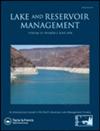入侵物种的相互作用影响浅层水库的营养循环:一个中生态实验
IF 0.8
4区 环境科学与生态学
Q2 Agricultural and Biological Sciences
引用次数: 0
摘要
【摘要】王志强,王志强,王志强,王志强。入侵物种的相互作用影响浅层水库的营养循环:一个中生态实验。湖泊保护区管理。XX: XXX-XXX。外来物种的引入可以影响营养动态,因为新的物种组合形成了新的生态系统。本实验研究了3种入侵物种,1种水下大型植物(水螅)和2种底栖无脊椎动物(Corbicula和Pomacea)的组合对美国佐治亚州塞米诺尔湖浅层水库养分循环的影响。为了评估这些影响,采用不同的入侵物种组合,在水库内安装了一个生态系统阵列。在为期5周的试验中,每周对所有中生态系统(1个对照,7个处理)的8项水质理化参数进行测定。水螅和Pomacea的存在对含氮化合物的影响较大,水螅中NO3-N浓度降低,Pomacea中NH4-N和总氮(TN)浓度升高。当Corbicula存在时,有助于缓解N浓度的增加,可能是由于过滤饲喂降低了水柱TN浓度。总体而言,水螅生长降低了无机氮浓度。放养Pomacea将储存态氮转化为速效态有机氮和颗粒态氮,但总磷浓度不受入侵物种处理的影响,且在试验期间各中生态系统中均有所升高。简而言之,水螅和Corbicula有助于吸收、转化和封存可能增加富营养化的营养物质,而Pomacea则释放潜在的富营养化营养物质。随着气候变化和人类的影响不断创造新的物种组合,了解新的物种组合所产生的影响是很重要的。关键词:Corbiculahydrillanonnative speciesnutrient processingPomacea AcknowledgmentsThe感谢作者布莱恩·克莱顿Bryan Cloninger娜塔莉·史密斯,巴里·谢尔顿,Golladay实验室协助现场和实验室。作者感谢Jean Brock对ArcGIS的帮助。作者还感谢3位匿名审稿人对本文早期版本的深刻评论。本项目的资金由国家科学基金会[DEB 1404160给A. P. Covich和S. D. Shivers]、伊乔韦的琼斯中心和佐治亚大学研究生院提供。本文章由计算机程序翻译,如有差异,请以英文原文为准。
Invasive species interactions affect nutrient cycling in a shallow reservoir: a mesocosm experiment
AbstractShivers SD, Golladay SW, Waters MN, Wilde SB, Marzolf NS, Covich AP. 2023. Invasive species interactions affect nutrient cycling in a shallow reservoir: a mesocosm experiment. Lake Reserv Manage. XX:XXX–XXX.Nonnative species’ introductions can affect nutrient dynamics as new combinations of species form novel ecosystems. This experiment investigated how combinations of 3 invasive species, 1 submerged macrophyte (Hydrilla) and 2 benthic invertebrates (Corbicula and Pomacea), affected nutrient cycling in a shallow reservoir, Lake Seminole, Georgia, United States. To assess these effects, an in-reservoir mesocosm array was installed using different combinations of the invasive species. Eight physical and chemical parameters of water quality were measured in all the mesocosms (1 control, 7 treatments) weekly for the duration of the 5 wk experiment. Nitrogenous compounds were strongly affected by Hydrilla and Pomacea presence, with NO3-N concentrations decreasing in Hydrilla mesocosms and NH4-N and total nitrogen (TN) increasing in Pomacea mesocosms. Corbicula, when present, helped to mitigate increases in N concentrations, presumably as filter feeding reduced water column TN concentration. Overall, Hydrilla growth reduced inorganic N concentration. Pomacea grazing converted stored N to available organic and particulate N. Total phosphorus concentrations were not impacted by the invasive species treatments and increased in all mesocosms during the experiment. In short, Hydrilla and Corbicula are contributing to the uptake, conversion, and sequestration of nutrients that may increase eutrophication, while Pomacea is releasing potentially eutrophying nutrients. As climate change and human influence continue to create new combinations of species, it is important to understand the effects produced by novel combinations of species.Keywords: Corbiculahydrillanonnative speciesnutrient processingPomacea AcknowledgmentsThe authors thank Brian Clayton, Bryan Cloninger, Nathalie Smith, Barry Shelton, and the Golladay lab for assistance in the field and laboratory. The authors thank Jean Brock for assistance with ArcGIS. The authors also thank 3 anonymous reviewers for their insightful comments on an earlier version of this article.Additional informationFundingFunding for this project was provided by the National Science foundation [DEB 1404160 to A. P. Covich and S. D. Shivers], the Jones Center at Ichauway, and the University of Georgia Graduate School.
求助全文
通过发布文献求助,成功后即可免费获取论文全文。
去求助
来源期刊

Lake and Reservoir Management
Environmental Science-Water Science and Technology
CiteScore
3.30
自引率
6.70%
发文量
0
审稿时长
>36 weeks
期刊介绍:
Lake and Reservoir Management (LRM) publishes original, previously unpublished studies relevant to lake and reservoir management. Papers address the management of lakes and reservoirs, their watersheds and tributaries, along with the limnology and ecology needed for sound management of these systems. Case studies that advance the science of lake management or confirm important management concepts are appropriate as long as there is clearly described management significance. Papers on economic, social, regulatory and policy aspects of lake management are also welcome with appropriate supporting data and management implications. Literature syntheses and papers developing a conceptual foundation of lake and watershed ecology will be considered for publication, but there needs to be clear emphasis on management implications. Modeling papers will be considered where the model is properly verified but it is also highly preferable that management based on the model has been taken and results have been documented. Application of known models to yet another system without a clear advance in resultant management are unlikely to be accepted. Shorter notes that convey important early results of long-term studies or provide data relating to causative agents or management approaches that warrant further study are acceptable even if the story is not yet complete. All submissions are subject to peer review to assure relevance and reliability for management application.
 求助内容:
求助内容: 应助结果提醒方式:
应助结果提醒方式:


